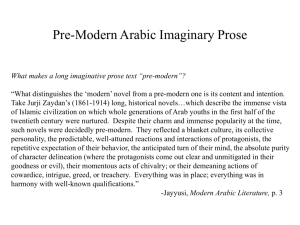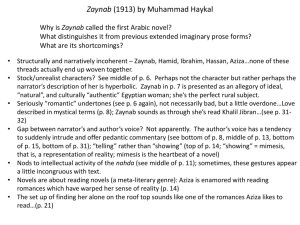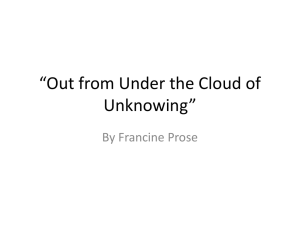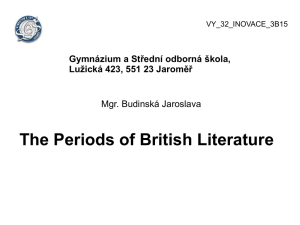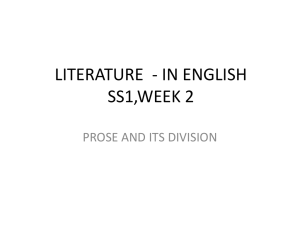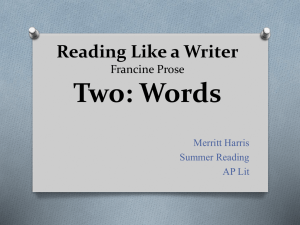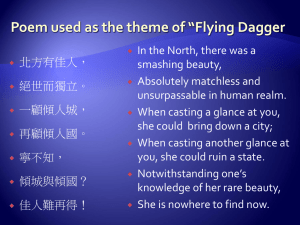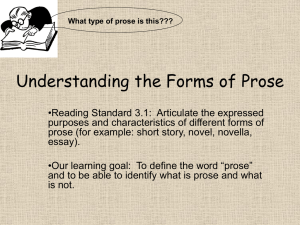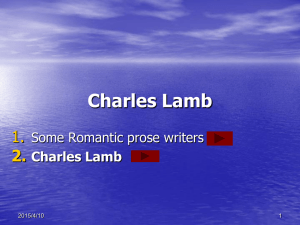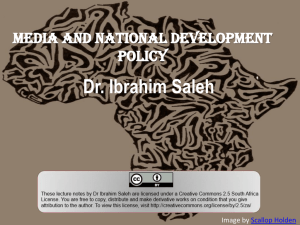Pre-Modern Arabic Prose
advertisement
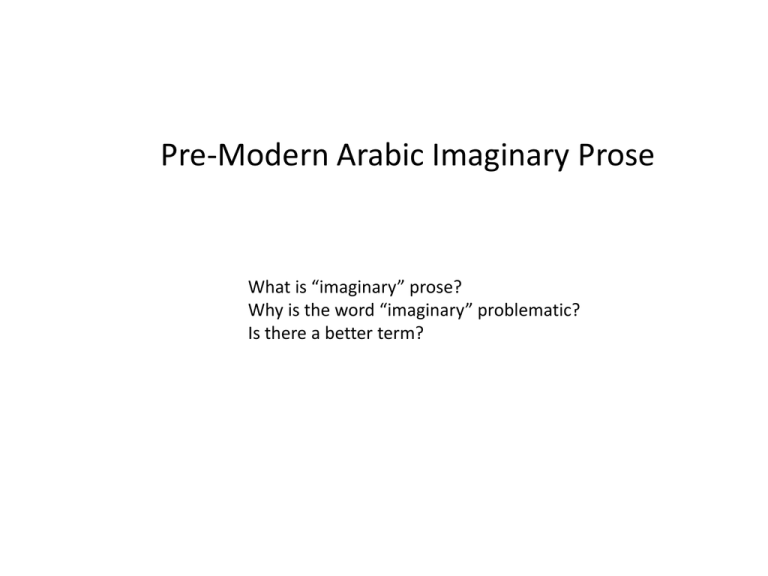
Pre-Modern Arabic Imaginary Prose What is “imaginary” prose? Why is the word “imaginary” problematic? Is there a better term? “Days of the Arabs” (Ayyam al-Arab) “Days” = Battles, events Historical or legendary? Literary or expository? Circulated as oral narratives, typically accompanied by poem(s) to which it serves as an “introduction” Stemming from earliest performances, or later when the audience no longer recalls or knows all of the contextualizing information? Invented to explain obscure poetry? Stories circulated and transmitted orally (through isnad [“A told B who told C who told D, etc.”]), then written down by Arab historians and philologists 200-300 years later! The Qur’an Is the Qur’an literature? If so, what marks it as literary? What is the relationship of the Qur’an to poetry? Types of speech within the Qur’an: a) Brief (often enigmatic) prophetic utterances (sajʿ) b) Stories and narratives c) Rules and regulations Influence of the Qur’an on Arabic literature? Kalila wa Dimna What marks this collection of stories as belonging to the realm of imaginary literature? What do these stories remind you of? What social and political service may these stories have played? Historical information: Translated from Middle Persian into Arabic by Ibn al-Muqaffa’ (himself a native Persian speaker). Stories originated in India from a collection of stories written in Sanskrit, known as the Pachitantra and attributed to the Hindu sage, Vishnu Sharma. The Maqama One of the first unique and truly indigenous Arabic literary prose genres, first composed by Ahmad “Badi’ al-Zaman” al-Hamadhani (d. 1008). Brief episodic or anecdotal texts set in the cities of the medieval Islamic world (Baghdad, Cairo, Basra, etc.) and typically featuring two stock characters: a gullible narrator/transmitter, Isa bin Hisham, and a wily swindler and hustler, Abu al-Fath alIskandrani. Very florid, exceedingly eloquent prose style (including long sections of saj’) – “verbal pyrotechnics” - used in a humorous and parodic fashion, since the stories themselves describe the seedy underbelly of the medieval Islamic city, with its ethnic and linguistic hodge-podge of con artists, peasant rubes, hypocritical holy men, lazy students, and uncouth bedouin. Vignettes, no character or plot to speak of; comic, socially realistic (but not linguistically so); no psychological depth or development – instead, stock characters. The Epistle of Forgiveness, by al-Ma’arri One of the earliest examples of extended imaginary prose; written, however, in conventional form as a letter (epistle) Very sardonic; deeply critical of orthodox religious theologians and preening men-ofletters (such as Ibn al-Qarih, whose pretentions to great eloquence al-Ma’arri mocks throughout). Depicts visit of Ibn Qarih to heaven, where he meets and interrogates a number of literary, religious, and cultural figures (including a number of pre-Islamic poets, famous for drinking ample quantities of wine). In doing so, al-Ma’arri skewers the like of Ibn Qarih - who tries to bribe his way into heaven with some cliché poetry, amongst other things – and the self-righteous theologians of his age. Al-Ma’arri, incidentally, was blind. Zaynab (1913) by Muhammad Haykal Why is Zaynab called the first Arabic novel? What distinguishes it from previous extended imaginary prose forms? What are its shortcomings? The Broken Wings (1912) by Khalil Gibran How do the prose writings of Gibran mirror his poetic works? Can we speak of “romantic-era” prose? The publication of The Broken Wings preceded the publication of Zaynab by one year. Why might it not have influenced modern Arabic prose writing to the same degree as Zaynab? What are its literary shortcomings?
